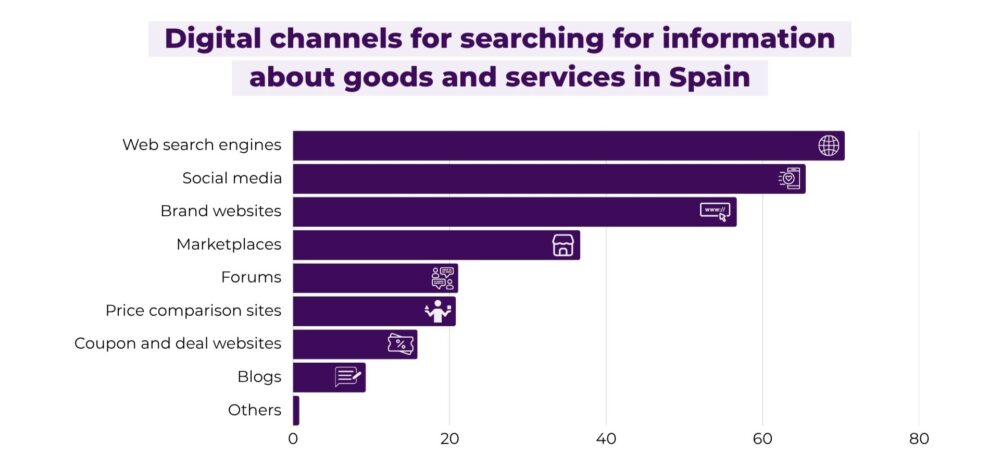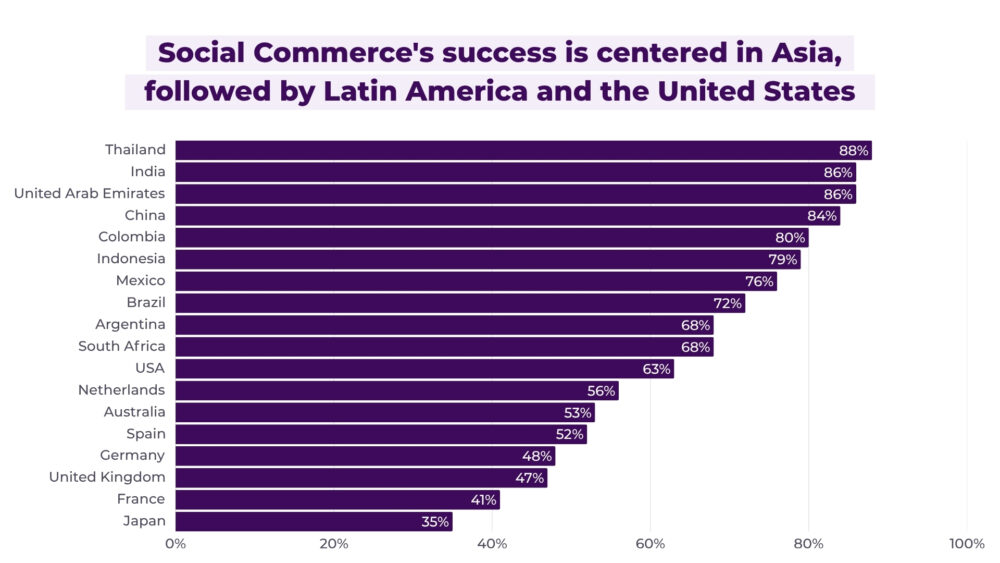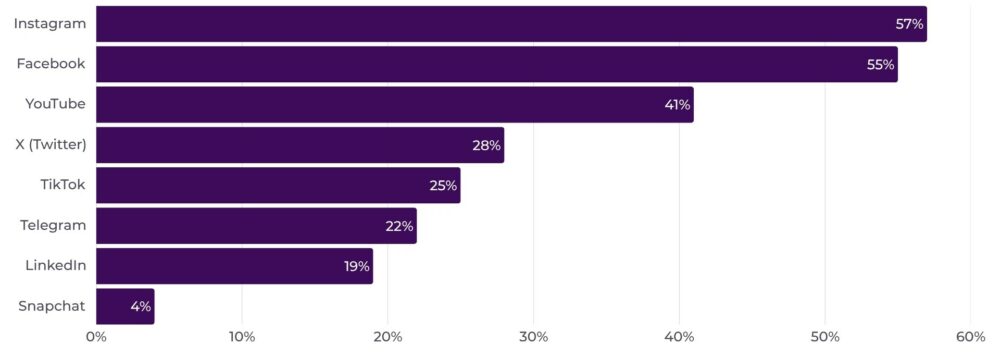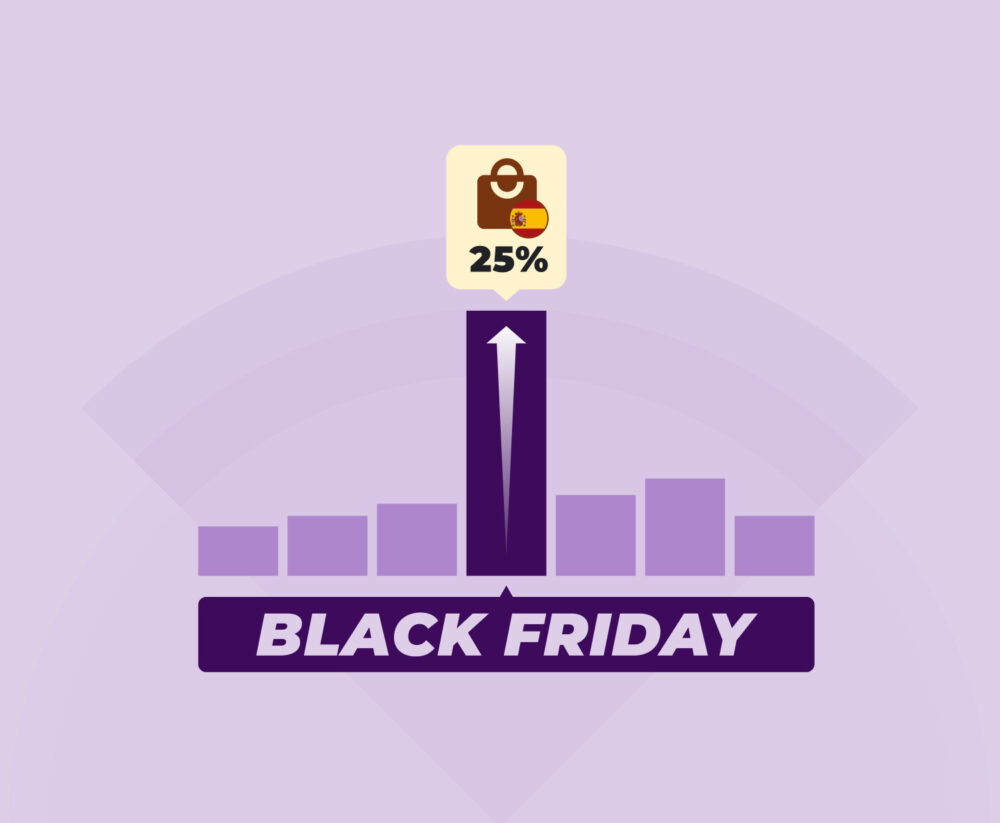Social Commerce and the Digital Shelf: How Brands Must Adapt to New Consumer Behaviour in 2025
Imagine you’re scrolling through Instagram, you see a product you like, and you can buy it instantly without ever leaving the app. That’s social commerce, a way of shopping that has completely changed the relationship between brands and users. In 2025, the line between social media and online shops has all but disappeared. It’s no longer just about searching for products on websites or marketplaces: now consumers discover, compare and buy directly from their favourite social networks. In a country like Spain, where 65.5% of those who look for information about products and services do so via social media, this channel has become a key space to have a presence.
Source: Online Shopping in Spain – 2024 Edition – Ontsi
Social commerce represents the natural evolution of e-commerce, where social networks become genuine points of sale. On the other hand, the digital shelf encompasses all the digital touchpoints where consumers can discover, research and buy products. The integration of these two areas offers enormous potential for brands. By combining social interaction with a solid digital presence, companies can create a seamless and appealing shopping experience. This not only improves product visibility but also sends conversion rates soaring.
In this article, we analyse how social commerce and the digital shelf are transforming shopping behaviour in 2025. You’ll see why this convergence is key for brands and what they must do to adapt to an increasingly digital, social and impulsive consumer.
Understanding the Ecosystem: Social Commerce and the Digital Shelf
To fully understand the opportunities that this integration presents, it is essential to understand what each concept represents and how they interact with each other.
Social Commerce has evolved from being simply advertising on social media to becoming a complete sales ecosystem. Think of the ‘shop now’ feature on Instagram, or live shopping events on TikTok. Social commerce leverages the interactive and community-based nature of social media to make the purchasing process more natural and fun. The key to social commerce lies in its ability to harness social influence and peer-to-peer recommendations to drive purchasing decisions. It also reduces friction, as the customer does not need to leave the platform to make a purchase. This translates into a more seamless user experience and, often, higher conversion rates.
The Digital Shelf, for its part, represents the collection of digital spaces where products can be discovered and purchased. This concept includes everything from marketplaces like Amazon to own-brand websites, mobile applications and price comparison platforms. The digital shelf is characterised by being dynamic, competitive and highly influenced by factors such as search engine optimisation, user reviews and the visual presentation of products.
Imagine this scenario: a customer sees a TikTok video of an influencer using your product (Social Commerce). They like what they see and click on the link to get more information. That link takes them to an optimised product page on your website, with professional photos, detailed descriptions and dozens of positive reviews (Digital Shelf). The synergy between engaging social media content and the comprehensive, reliable information on the digital shelf creates a much more effective path to purchase. By integrating both, brands can guide the consumer from discovery to purchase in a seamless and compelling way.
Key Trends in Social Commerce for 2025
The social commerce landscape is evolving rapidly. In 2025, several trends will become more established, offering new opportunities for brands looking to maximise their conversions.
1. The growth of Social Commerce and its market penetration
Social Commerce has experienced exponential growth that has surpassed all initial projections.
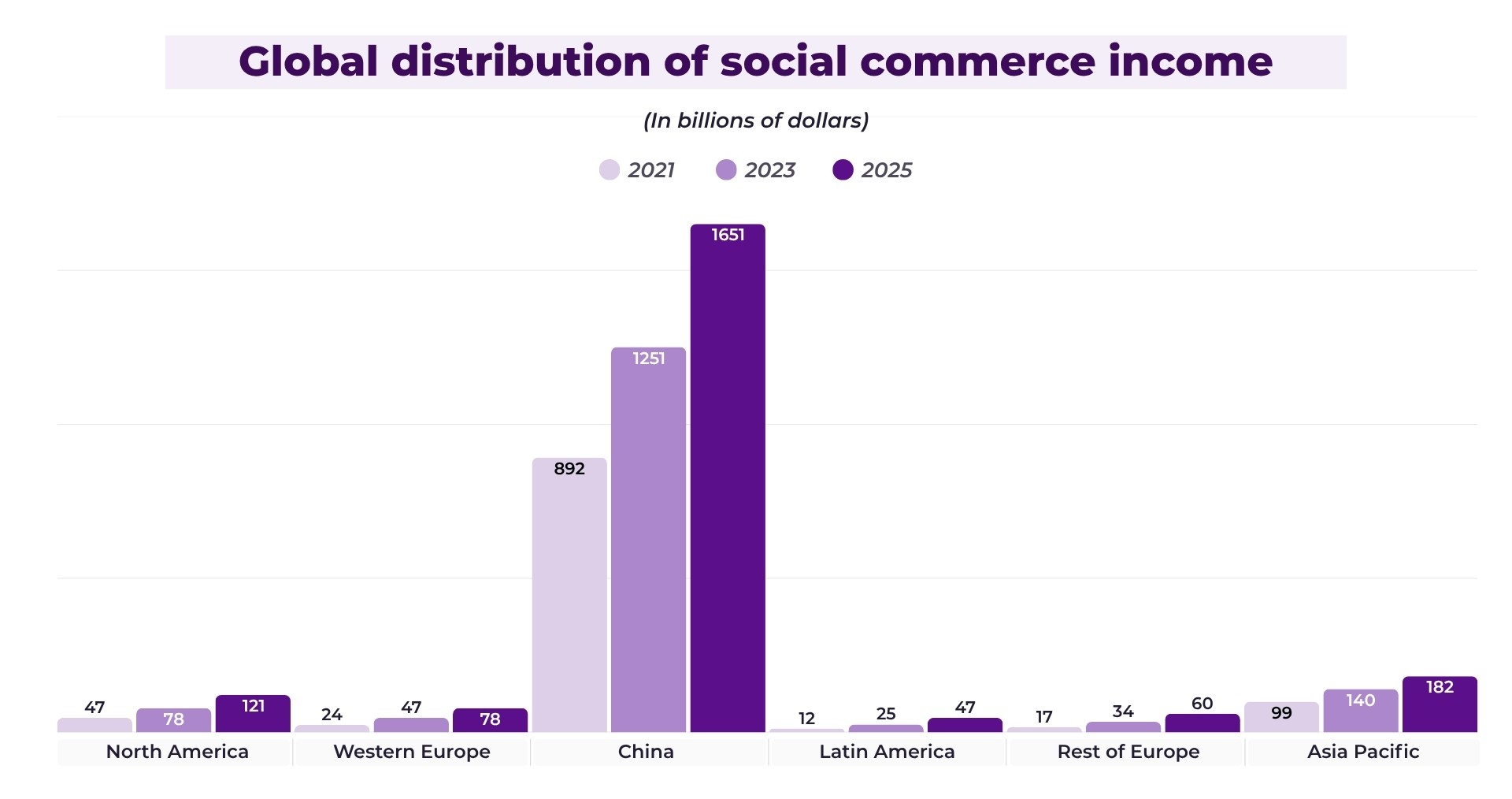
Source: Deloitte – 2023
This growth is mainly due to generational shifts in consumer habits. Younger consumers have adopted social media not just as spaces for entertainment, but as genuine channels for discovery and purchasing. This trend has forced brands to rethink their marketing and sales strategies.
The penetration of social commerce varies depending on product categories. The fashion, beauty and lifestyle industries are leading the way in adoption, while sectors such as technology and home appliances are experiencing accelerated growth. This differentiation by category requires brands to adapt their strategies according to their specific sector.
Geography also plays an important role in the adoption of social commerce. Asian markets such as Thailand and China continue to be pioneers in innovation, while Western markets like the United States and Europe are experiencing faster-than-expected adoption.
Source: Vecdis, based on data from Wunderman Thompson Commerce and Tidio – 2024
2. Leading platforms (TikTok, Instagram, YouTube) and new functionalities
The main social media platforms are investing heavily in social commerce functionalities.
- TikTok: It remains the undisputed leader in short-form video and has hugely boosted live shopping (live shopping). Its product integration tools allow brands to tag items directly in videos, and users can buy with just a couple of clicks. The immersion and entertainment that TikTok offers are ideal for social commerce.
- Instagram: With its Instagram Shops (Instagram Shops), product tags in posts and Reels, and checkout integration, Instagram has been a pioneer in social commerce. The platform continues to focus on the visual shopping experience and influencer integration.
- YouTube: It has expanded its e-commerce capabilities through live shopping, product tags in videos and YouTube Shorts. Given its huge creator base and its long-form video content, YouTube offers a unique space for detailed product demonstrations and shopping tutorials.
In addition to these, other platforms such as Pinterest and Facebook also offer robust functionalities. It is crucial for brands to assess where their main audience is and adapt their strategy to the specific tools of each platform.
Main social media networks used by internet users to buy on marketplaces in Spain in 2024*
Source: Statista – 2025
*Note: It should be noted that TikTok Shop was not available for purchases in the Spanish market until December 2024, and yet it still achieved remarkable penetration in just one month.
3. The role of Gen Z and Millennials in adopting these trends
Gen Z (born between 1997 and 2012) and Millennials (born between 1981 and 1996) are the main drivers behind the adoption of social commerce. Their shopping behaviours are characterised by the search for authenticity, the influence of social recommendations and the expectation of frictionless shopping experiences.
- Digital natives: They have grown up with social media and feel comfortable interacting and shopping on these platforms. For them, social shopping is a natural extension of their digital lives.
- Influence of creators: They trust recommendations from influencers and content creators more than traditional advertising.
- Search for authenticity: They value user-generated content (UGC) and shopping experiences that feel genuine and less ‘salesy’.
- Impulse and instant gratification: The quick-buy features and entertainment offered by social commerce platforms fit perfectly with their consumption patterns.
For brands targeting these demographic segments, it is important to be on social media and to effectively integrate social commerce into their overall strategy.
Looking Ahead: Integrate to Convert
Social commerce is no longer an emerging trend: it is an established reality that is redefining how consumers discover, evaluate and buy products. In 2025, this shopping model is setting the pace, especially among the younger generations, who value immediacy, authenticity and recommendations from people they trust.
Platforms like TikTok, Instagram and YouTube are leading this change with new functionalities that naturally integrate sales into the user experience. But the real potential emerges when social commerce is combined with a well-optimised digital shelf strategy: well-kept product pages, relevant content, visible reviews and a frictionless experience.
This integration between social discovery and digital conversion allows brands to create much more effective customer journeys, which accompany the consumer from inspiration to the final decision. In this new scenario, adapting is no longer an option, but a strategic necessity to remain competitive.
Brands that understand and act on this convergence will be better prepared to stand out in an environment where the digital and social channels are, increasingly, one and the same.

